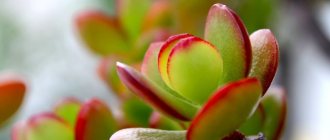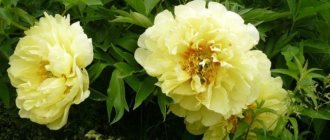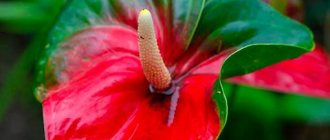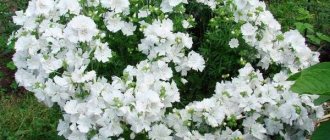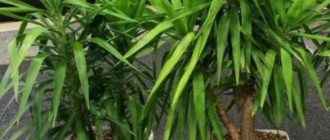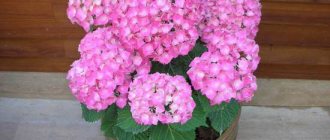Even the brightest flowering species can envy the luxury of the colors of the leaves of the royal begonia. Metal, acrylic, powder, stains and veins are mixed in thousands of variations, creating a delightful kaleidoscope and surprising fans every year with new varieties. If you fall in love with royal begonia and learn how to properly care for it, compiling your own collection will almost certainly become an exciting hobby for you. But finding an approach to a plant is not always easy. Royal begonias react quite sensitively and painfully to mistakes, and not only with lighting and watering.
Royal begonia - amazingly decorative leaves
Begonia royal (Rex)
An incredibly spectacular indoor plant, the royal begonia is often also called the Rex begonia. This ornamental plant is quite popular in indoor culture due to its large leaf plates that have an unusual color and shape. The flower also has the ability to make the air in the room cleaner.
Often you can understand that this flower is truly incredibly beautiful only by seeing it with your own eyes. The fact is that even the highest quality photographs cannot convey all the beauty of the royal begonia.
Growing conditions for indoor royal begonia
Soft warmth and diffused light - rex begonias of all varieties require special, protected conditions. They are not as hardy as many of their relatives.
Lighting and placement
To find a suitable location, it is best to focus on the western and eastern window sills, where royal begonia develops best, enjoying the soft morning or evening sun. She needs diffused, soft light. On a northern windowsill it will suffer even in summer; with a southern orientation, the bushes can be moved away from the window, but only slightly. Additional lighting is acceptable in collections, but usually Rex begonias require natural lighting.
Royal begonia grows well in groups, including with other plants that require similar conditions (for example, with indoor ferns). It needs to be placed in such a way that the beauty of the leaves is revealed and visible as much as possible: the “cleaner” the background, the better.
Features of Rex begonia
Royal begonia is a member of the Begoniaceae family, which includes more than 1,600 species. Moreover, such a large family received its name in honor of Michel Begon, who was a Frenchman.
The plant has spectacular asymmetrical leaf plates with a carved edge. They can be painted in a variety of shades and their combinations (depending on the variety). Begonia has a fleshy, voluminous rhizome that rises slightly above the surface of the substrate.
During the flowering period, small unsightly flowers appear on the bush. Since they have a nondescript appearance, they do not represent any decorative value. Therefore, Rex begonia is grown as an ornamental foliage plant.
Caring for royal begonia at home
Royal begonia, grown at home, is distinguished by its undemanding and unpretentiousness. However, in order for a flower to look as impressive as possible, it still needs to be provided with proper care and favorable conditions for growth.
Choosing a location and lighting
It is important to take into account that this plant is light-loving. If you place it in a well-lit place, the foliage will be bright and dense. In this case, the light should be bright, but diffused.
Shaded places or northern windows are completely unsuitable for Rex begonia. You should also choose places protected from direct sunlight. The fact is that when exposed to them, burns can form on the foliage, which in turn often causes the leaf blades to die.
Temperature
In the warm season, the plant feels best at a temperature of about 25 degrees. If the room is colder than 15 degrees, this can lead to the leaves flying around and even to the death of the flower. During the winter months, the plant can be kept cool (about 17 degrees). But remember that this is a tropical plant, and therefore it is heat-loving.
Watering
The plant responds well to regular watering (the soil mixture should always be slightly moist). However, do not allow liquid to stagnate in the root system. Water the bush moderately but often (about four times every 7 days). Moisten the substrate only after its top layer has dried.
As for air humidity, it should be high. But it is highly undesirable to spray foliage with a spray bottle. Instead, moisture is sprayed around the plant itself or an open container filled with water is placed next to it.
Since a large amount of dust settles on the surface of the large leaf plates of Rex begonia, which it attracts from the air, they must be systematically wiped. To do this, use a moistened soft cloth. Be extremely careful when doing this, as the plant is extremely fragile and can be easily injured.
Fertilizer
In order for the bush to develop correctly, it should be systematically fed. To do this, it will be enough to apply the mineral complex once every 30 days, while the fertilizer is dissolved in water for irrigation.
Transfer
Begonia needs annual transplantation and rejuvenation every 3-4 years. In other words, every 3-4 years a new cutting is planted, which will subsequently replace the old begonia. When replanting a plant, you can use purchased soil or prepare it yourself, as it is not difficult. The substrate for planting begonias consists of: 2 parts of leaf soil, 1 part of turf soil and 1 part of peat and coarse river sand. You can add coniferous tree bark, vermiculite, leaf or turf humus to the finished substrate. This will allow the soil to breathe. At the same time, you should pay attention to the presence of effective drainage so that the water in the container does not stagnate.
When transplanting, you should choose a wide, but not deep, container. This is due to the structure of the begonia root system.
Alternatively, you can plant several begonias of different varieties in one suitable container. The result can be a very original decorative composition.
Source
Tuberous begonias, rex and hybrid Gluard de Lorraine
Based on the structure of the root system, begonias can be divided into three groups:
- begonias having tuberous rhizomes;
- begonias with branched rhizomes;
- begonias having a fibrous root system.
The figure below, “Tuberous begonias, rex and hybrid Gluard de Lorraine,” shows three representatives of these groups: the top photo on the left is rex begonias; lower left - hybrid Gluard de Lorraine; on the right are tuberous begonias.
Rice. Tuberous begonias, rex and hybrid Gluar de Lorraine * 3 *
Tuberous begonias
Tuberous begonias are grown in large quantities for planting in flower beds and in relatively smaller quantities for indoor landscaping. In rooms where pelargoniums and petunias bloom poorly due to lack of light; Tuberous begonias bloom well in summer on northern windows.
In greenhouses, flowering tuberous begonias can be kept in bloom until early November.
Begonia rex
A distinctive feature of this species is that rex begonias are used to decorate a room not as a flower, but because of their lush, variegated foliage, which is famous for its variety of colors.
Hybrid begonias Gluard de Lorraine
Hybrid begonias Gluard de Lorraine were bred in France about seventy years ago. They bloom from November to February. In Europe, this crop occupies a prominent place in greenhouses.
Types of begonia
In total there are about a thousand species of begonias. In addition, the work of breeders has bred more than two thousand hybrids, while the number of varieties is constantly growing. The most popular types are: royal begonia, tuberous, ever-blooming, elatior, ampelous and tiger.
Royal begonia
There are varieties with almost black leaves with small scarlet patches. These begonias bloom inconspicuously, with small pink flowers, which I try to remove at the bud stage. Most often, collectors can find the following varieties:
Tuberous begonia
There are also two-color varieties, such as begonia "Marmorata", its double flowers are decorated with streaks and a border on the petals. The most popular are:
Begonia everblooming
The plant is a bush with a fleshy, erect stem and oval, slightly pubescent leaves. The color of the leaf blade can be all shades of green, as well as burgundy or red-brown. Flowering is not very abundant; most often there are from 2 to 4 simple flowers on the peduncle. Color varies from white to red, and there are varieties with edged petals. The flowering of such begonias is long and continuous, until frost. The following varieties are especially popular:
Begonia elatior
Most often, fans can find the following varieties:
Begonia ampelous
The most common hanging begonias are the following varieties:
Begonia tiger
Like other similar species, the flowering of tiger begonia is not particularly attractive; I try to remove flower stalks at the budding stage. Varieties such as “Tiger” and “Cleopatra” will decorate any home collection.
Caring for begonia at home
Despite such diversity, care for all types is approximately the same. In order to grow a healthy plant with painted leaves or lush flowering bushes, you need to pay attention to the following nuances:
- Lighting. Begonias do well on bright windowsills, protected from direct sunlight. Some decorative foliage species do well in shaded areas in the back of the room. Decorative flowering varieties require light. My beauty pleases with long-term flowering near an east-facing window;
- Temperature regime . The optimal level is 18-20 degrees, but in the summer, begonias tolerate higher values. Still, try to adhere to the specified norm. Begonia also does not like sudden changes in temperature, so do not rush to take the flowerpots out into the open air until persistent warm weather sets in;
- Air humidity. Begonia is native to the tropics, so you should stay as close to a humid climate as possible. The plant tolerates the heating season especially poorly. Spraying is contraindicated for all types of begonias; the problem is solved by installing special humidifiers. If you are not ready to spend money, you can get by with a tray filled with pebbles or moss. Pour water into it, and place a pot with a plant on top;
- Watering. Begonias cannot tolerate waterlogging; this is the most common cause of death. Watering is necessary if the top layer of soil has dried to a depth of at least 2-3 cm. The optimal method of moistening is watering through a pan. I water my plants once or twice every 7-10 days. I fill the pot with water and immerse the pot in it for 15-20 minutes, take it out and let the excess water drain well. Garden begonias are watered carefully, trying not to get on the above-ground part of the plant;
- Drafts. A very important point. Begonias love space and fresh air, but they absolutely cannot tolerate drafts and windy balconies and terraces. If you take the flowerpot outside, be sure to install a protective screen.
Begonia cultivation and care
Exquisite begonia is an absolutely unpretentious plant. Flowers growing in their natural environment can adapt to a variety of conditions. Flowers feel most comfortable in a moderately shaded area with low humidity and acceptable temperature.
Types of begonia
Note! In the middle zone, the flower of the Begoniaceae family is grown indoors. However, you can try growing tuberous plants in open ground.
It is best to plant the plant in the garden in early June. During this period, the threat of frost has passed. For the flower, you need to choose a shaded place or an area with diffused sunlight.
The plant is propagated by cuttings.
Landing rules
Before planting a plant, it is important to carefully read the growing rules:
- Before seedlings are planted in open ground, they should be hardened off - the main condition that will help young bushes grow stronger. To do this, you will need to place them for 7 days in a well-lit room, the temperature in which is within 22-26 °C during the daytime, 12-15 °C during the dark.
- For growing begonias, a soil mixture containing leaf soil, peat, sand and humus is suitable. The components must be connected in a ratio of 1:0.5:0.5:0.5.
- After preparing the soil, planting takes place. A drainage mixture consisting of fine crushed stone, expanded clay or coarse sand is poured onto the surface of the bottom of the hole. Then the hole is filled with a mixture of peat and compost. If desired, this mixture can be replaced with potassium-phosphorus fertilizer.
- After planting the seedling, it must be watered abundantly and the soil around the trunk should be covered with wood ash. To avoid soil freezing at night, you can cover the ground with agrofibre or film material.
Begonia ampelous
Lighting
Begonia needs soft lighting in the morning and evening. The large-leaved plant species, painted in white, silver and red tones, is very demanding of such lighting. In the cold season, it is worth placing flower pots on the south side. During the hot season, it is worth moving the pots to a shaded place so that the delicate foliage does not burn.
If plants lack natural light, you can periodically turn on fluorescent phyto-lamps. Everblooming and deciduous flower species require 12 hours of daylight.
Temperature
The optimal temperature for growing begonia is within 18-19 °C in the summer and 11-14 °C in the cold season.
Important! At temperatures below +4°C, the bushes of the plant die, losing not only flowers, but also foliage. However, it is unacceptable to allow very high air temperatures, at which the flowers dry out.
Humidity
According to the observations of experts, the best development of indoor flowers of the Begoniaceae family is observed at air humidity in the range of 50-55%. It is unacceptable to place pots with plants in close proximity to heating appliances, gas stoves or convectors. Combustion products emitted by equipment have a detrimental effect on flowers.
It is advisable to place an automatic humidifier near the pot with begonia. If this is not possible, you can systematically spray water near the plant, preventing the log from getting on the foliage. Moisturizing procedures should be carried out in the morning and evening hours.
Begonia everblooming Bada bing
Watering
A large number of plant varieties can easily withstand short-term dry periods. Excessive soil moisture, on the contrary, can lead to diseases and death of the bush. The tuberous type of bush should be moistened when the substrate dries to half its depth. Branched fibrous roots will require more liquid. For irrigation, you can use water that has settled or been filtered. The water temperature should be room temperature.
Fertilizers and fertilizing
Begonia needs systematic vitamin and mineral feeding. It is advisable to fertilize every 14 days from the beginning of spring to mid-autumn. In winter, flowers remain dormant.
In a specialized store you can find a huge number of preparations that are produced for feeding begonias. They are made on the basis of a water-soluble complex of useful elements, which enable the bushes to maintain health during the active growth phase and during the flowering period.
Begonia propagation
Growing a young plant is quite simple and even novice gardeners can do it. The method of propagation depends on the type of begonia.
Begonia propagation by leaf
This method of vegetative propagation of begonias is suitable for decorative deciduous species. From one healthy leaf blade you can get several plants at once. The step-by-step process looks like this:
- Using a stationery knife or blade, make small cuts along the prominent veins of the leaf on the inside;
- Trim the cutting, leaving 1/3 of its length;
- Fill a bowl or bowl with water and place the leaf on the surface of the water. After 10-15 days, small roots should appear.
You can also use leaf fragments:
- Using a sharp knife, cut the plate into cone-shaped fragments with a vein;
- Fill the tray 1/3 full with universal substrate, moisten it;
- Using a large spoon, make indentations on the surface of the soil, place part of the leaf in it, corner down, carefully sprinkle with soil and compact the mixture;
- Cover the tray with glass or film and put it in a warm place, protected from direct sunlight. Do not forget to moisten the mixture and ventilate.
Source
Reproduction methods
Leaves and cuttings
Cuttings are the easiest and most common way to propagate Rex begonias. Using a disinfected knife, a leaf or cutting is separated from the parent plant. It is placed in a solution that stimulates root growth. Instead, you can use regular well-settled water. Young roots will appear in just a few days. The cuttings with roots should be planted in a small separate pot.
ROYAL BEGONIA. REPRODUCTION.
Propagation by tubers and roots
Inexperienced gardeners should avoid this method of propagation. The fact is that you will definitely need to find a growth bud on the rhizome. However, experienced flower growers often use this particular method of flower propagation. Please note that varietal begonias are not often subjected to division of the root system.
Growing from seeds
Growing begonia from seeds is quite difficult. The seed material is more like dust, so difficulties arise already at the sowing stage. Also, the seeds have low germination. Most often, begonia is grown from seeds by breeders in the process of creating new varieties.
Royal begonia: types and features of care
Today we’ll talk about how to care for royal begonia at home. The beauty of this truly royal flower is breathtaking, and one can talk about the usefulness of the plant for hours. Begonia with large pointed leaves cleanses the air of harmful impurities, attracts well-being into the house, imparts self-confidence, etc.
Briefly about care
| Type of agricultural operation for caring for Rex begonia | Description of conditions and actions |
| Watering and air humidity | Watering at the root, not very abundant; from spring to autumn - up to 4 times a week (as the top layer of soil dries); In winter, watering is reduced. There is no need to spray; the casting should be wiped periodically with a damp cloth. High humidity required |
| Lighting organization | Diffused sunlight, partial shade in winter requires artificial lighting in summer needs shading |
| Maintaining a rest period | October to March (some species do not hibernate) |
| Creating temperature conditions | From +17 to +25 °C afraid of drafts and low temperatures; rest period not lower than +16 °C |
| Trimming | The first pruning is carried out when the plant height is 10–12 cm; during the flowering period, peduncles that deplete the begonia are removed |
| Making soil mixture | Nutritious, loose, moderately acidic soil mixture of peat, sand, leaf and turf soil (1:1:2:1) You can add vermiculite or pine bark |
| Fertilizer application | Once a month in the spring, nitrogen-containing mineral fertilizers are applied, and in the summer, phosphorus-potassium compounds are applied. Mineral fertilizers should be alternated with organic matter: 200 g of cow manure per 1 liter of water, and do not feed in winter |
| Transfer | Replant annually after dormancy, rejuvenate every 3–4 years |
| Chemical treatment | Insecticides: aphids, poutine mites, greenhouse whiteflies, soft scale insects, thrips; fungicides: gray mold, powdery mildew, bacterial spot, ring spot |
Pests, problems, diseases and treatment
Begonia is a fairly delicate plant that is susceptible to fungal, viral, and bacterial diseases.
The flower suffers from gray and black root rot, botrytis, downy mildew and powdery mildew. Such diseases can be cured with fungicidal drugs.
But lethal to begonias are: tomato spot, bacterial wilt and cucumber mosaic.
Failure to follow the rules in care can also lead to a number of problems. Drying and falling leaves indicate a lack of watering and humidity. But a sharp yellowing of the leaves signals excess moisture and low temperature.
Most often, domestic begonia is susceptible to attack from aphids and spider mites. Any insecticide is effective against these parasites.
The most dangerous pest for begonias is the nematode. It quickly destroys the plant and leads to its death. It is not possible to rid begonia of nematodes.
Description of the plant
Royal begonia, also known as Begonia Rex, is a hybrid variety of the Elatior group, bred by crossing Socotrans and tuberous begonias. Perhaps this is the most beautiful and original flower in the world, deservedly called royal. Almost all of its varieties have asymmetrical carved leaves ranging from bronze-chocolate, almost black, to cherry-red with a luxurious silvery sheen.
Royal Begonia Rex
Due to the heart-shaped base and sharp edge of the leaves, the royal begonia is also called “Napoleon’s Ear”, “Elephant Ears”. The surface of the leaf blade is velvety, slightly pimply, covered with short villi. The back side is covered with red veins.
By crossing Rex begonia with other varieties, unusual hybrids with fringed or spiral-shaped foliage were formed.
A rather large, dense creeping rhizome protrudes above the surface of the ground. After the lower leaf plates dry out, marks remain on the rhizome.
In nature, the herbaceous perennial grows in the tropical forests and mountains of Eastern India. We grow it exclusively at home. In order for an exotic beauty to fully develop, she needs to be provided with conditions as close as possible to the humid climate of her historical homeland.
Flowering is sparse, flowers are small and not particularly attractive. They are not the main decoration of the plant, since they are significantly less decorative than the leaves.
Royal begonia blooming
It is impossible to convey all the charm and versatility of Rex begonia from a photo. In fact, the tropical plant is much more beautiful.
Helpful information! The fleecy leaves of the royal begonia purify the indoor air from germs and dust. Therefore, the plant needs regular wet cleaning, at least 2 times a month. Gently wipe each leaf with a damp flannel cloth. Do not forget about the fragility of the tropical guest and that it can break from any careless movement.
Popular varieties and hybrids of royal begonia
Among the variety of varieties and hybrids of royal begonia, you can get confused. Moreover, each individual variety is unique in its own way. We present to your attention the most interesting plants suitable for growing indoors:
Mini Mary Christmas
Begonia "Mini Merry Christmas" (B. Mini Merry Christmas) is the most variegated variety of royal begonia, growing up to 30 cm in length. From the brown center of the leaf blade, bright green spills out, turning into a wide red-crimson border. The entire surface is strewn with bright pearlescent specks. The top of the leaf is velvety, the back is cut with large veins.
Begonia mini merry christmas
Griffon
The tallest and longest lasting royal begonia (B. Griffon) is often used in landscape design. In this case, the shrub is grown as an annual. In the home flower garden, it is a perennial with a height of up to 41 cm. Large white-green leaves with dark veins calmly tolerate dry air (which cannot be said about the parent of the hybrid).
Royal begonia griffon
Escargot
Because of the bizarre shape of its leaves, the Escargot begonia (B. Escargot) is called the “royal snail.” A rather wide bush, 30 cm high, consists of large matte fleecy leaves, twisted at the base into a double spiral. A curved silver stripe runs through the dark olive base of each leaf, separating the center from the edge.
Royal begonia escargot (begonia escargot)
Dollar Down
The neat, no higher than 30 cm bush “Dollar Down” (B. Dollar Down) is unlikely to go unnoticed. Shiny, as if varnished, bright burgundy leaves have a fan-shaped, spiral shape. The veins and border are painted in a contrasting almost black color.
Begonia dollar down
Royal minuet
Begonia (B. Regal Minuet) is distinguished by its thinnest leaves, which, with sufficient lighting, acquire a pronounced burgundy color. If there is not enough light, the leaves turn pale and become pearlescent pinkish. The center and edge of the leaf plate are colored dark chocolate.
Begonia regal minuet
Red Leaf Fista
The compact and low-growing “red-leaved feastii” (B. erythrophylla/feastii) has an easy-going nature. Perhaps this is the most easily accessible variety, most often found on sale than others. The leaves are rounded on top, like geraniums, and painted a rich green color. The color on the back is burgundy. In the photo it is difficult to appreciate all the charm of this royal begonia, and as an indoor flower it requires minimal conditions.
Begonia erythrophylla/feastii
Chocolate cream
The stunningly beautiful begonia “chocolate cream” (B. Chocolate Cream) amazes with its versatility of color. Large, spiral-shaped leaves at the base are the color of an unripe dessert plum with a silver-pink tint; the top is covered with veins and a fringed edging of a rich dark chocolate shade.
Begonia chocolate cream
Evening Glow
The hybrid (B. Evening Glow) has not very large, pearlescent soft green leaves with a juicy crimson center, from which brownish-green rays-veins emanate. A thin crimson border runs along the edge.
Begonia Evening Glow (begonia evening glow)
Black Mamba
Begonia (B. Dark Mamba) is called black mamba because of the unusual color of the leaves. The velvet surface is black and green. The back side is pink-brown. Pale green rays extend from the center of the spiraling, wavy leaves. This plant looks luxurious in a bright interior.
Begonia dark mamba
Varietal diversity of royal begonia
Entire encyclopedias can be devoted to the delightful palette of varieties and hybrids of royal begonia. Any catalog of highly specialized companies looks like an endless kaleidoscope of colors and shapes. And it is impossible to cover all this diversity in one review. It is better to buy and choose royal begonias literally according to your taste - according to details, shape, size, shades, foliage effects.
Ten favorite varieties of recent years:
- “Escargot” is an exemplary “snail” variety with a strongly spiraled base, the shape of a leaf with a densely wavy edge and an unpronounced apex is emphasized by the contrast of a brownish-olive border and spot in the center with a creamy-silver central part;
- “ Silver Cloud” is an amazing creamy-powdery variety with dark chocolate veins at the base of the leaf;
- 'Rocheart' is a speckled favorite with dark, almost chocolate-colored leaves adorned with a cherry heart-shaped spot and border all dotted with small white specks;
Begonia rex, or Royal Begonia (Begonia rex), variety “Escargot”. © Leonora (Ellie) Enking
Begonia rex, or Royal Begonia (Begonia rex), variety “Silver Cloud”. © Leonora (Ellie) Enking
Begonia rex, or Royal Begonia (Begonia rex), variety “Rocheart”. ©frustratedgardener
- “ My Best Friend” is an almost white variety with thin bloody veins, in which small white specks festively shine on a dark green border;
- "Fireworks" is a beige-pink variety with a very bright pattern of dark, rich brown veins, as if exploding at the base and spreading across the leaf, emphasizing the light shade of the center of the leaf blades and the pink-metallic border;
- “Inca Night” is an attractive two-color variety with perfectly heart-shaped leaves with a strongly pointed apex and finely wavy edge with a dark pink heart and a wide dark brown border;
- 'Evening Glow' is a small-leaved variety with heart-shaped leaves that have a dark metallic pink edge and the center of the leaf is highlighted by a wide silver zone and a dark cherry spot.
Begonia rex, or Royal Begonia (Begonia rex), variety “My Best Friend”. © Dibleys
Begonia rex, or Royal Begonia (Begonia rex), variety “Inca Night”. © balconefiorito
Begonia rex, or Royal Begonia (Begonia rex), variety “Evening Glow”. © A'rie
- "Merry Christmas" is a favorite variety with a multi-flowered pattern, which has patches of dark cherry, pink, silver, bright green and purple from the base to the edge;
- “ Beleaf African Jungle” is a bright green variety with a large dark ink spot and a thin dark border, against which rare white and pink splashes seem very bright;
- "Red Robin" - red-brown, with a wide border and large teeth along the edge, a very compact and lush variety.
Begonia rex, or Royal Begonia (Begonia rex), variety “Merry Christmas”. ©Verde_Alcove
Begonia rex, or Royal Begonia (Begonia rex), variety “Beleaf African Jungle”. © Bakker
Begonia rex, or Royal Begonia (Begonia rex), variety “Red Robin”. © growjoy
What is important to know before purchasing
In a series of decorative foliage plants, Rex begonia is the queen, which has no competitors in brightness and originality. It is readily grown by experienced gardeners and beginners, captivated by the unpretentiousness of the tropical beauty. If you also want a plant for your home flower garden, first read the following table:
| Mature plant size | From 15 to 40 cm in height, leaf size up to 30 cm, the width of some specimens reaches 45 cm |
| Lifespan | Up to 10 years or more |
| Bloom | Blooms; flowers pink, pale pink, white, beige |
| Aroma | Without smell |
| Safety | Not poisonous |
| Difficulty of care | Unpretentious plant |
| Uniqueness | Common type |
| Where can I buy |
The highly titled plant differs from its “relatives” by its amazing brightness, regardless of flowering. Begonia Rex may not bloom at all and will only benefit from this. The fact is that inconspicuous buds deprive the plant of its vitality and, in order to preserve the decorative appearance of the leaves, experienced gardeners cut off the flowers.
Interesting fact! Begonia Rex is the flower of businessmen. By placing a houseplant in your office, you can rest assured that it will protect you from rash actions and help you find the only right solution.
Recommendations from an expert: rejuvenate correctly
Royal begonia is replanted every spring. An equally important procedure is plant rejuvenation, which is carried out every 3-4 years. With the right approach, you can significantly increase the life of a plant and grow a young bush from a mother cutting.
No, we will not rewrite information that is repeated many times on various sites. We better use the experience of knowledgeable flower growers Pavel and Elena Enikeev, who have been leading the YouTube channel since 2009.
Rejuvenation of the royal begonia Lilian
The royal variety Lilian is used as an example. The rejuvenation procedure consists of several stages:
- Removing fresh and old flower stalks. Old ones fall off at the slightest touch, fresh ones are cut off with sterile sharp scissors.
- Inspecting the plant and soil in the flower pot for dry leaves. Remove them also mercilessly, as they can be carriers of all sorts of diseases.
- Removing plant leaves with spots and other signs of illness. They should easily lag behind the bush. Such leaves should be thrown away immediately and not used to propagate begonias.
- Removing low-growing leaves, if any (applies to plants with elongated stems that will have to be buried when transplanting). These leaves can and should even be used to produce young plants.
- Removing a plant from a flower pot. A healthy begonia has white roots. If the soil is moist, the roots take on a yellowish tint.
- Preparing a new pot. It should be larger in diameter than before. If the begonia grew in a 12 cm container, it should be transplanted into a 15 cm container.
- Trimming soil penetrated by the root system. You can simply unscrew and tear off half of the substrate-root mass with your hands. The top layer should be left for better survival of the plant in the new container.
- Preparation of a soil mixture from leaf soil, turf soil, peat, river sand (2:1:1:1) and a small amount of crushed coniferous tree bark.
- Planting begonias. Deepen the bush to the level of the lower leaves, fill all the voids with substrate, and tamp lightly. To prevent the plant from staggering, the trunk circle must be pressed with your fingers.
It will take about 4 weeks for the begonia to adapt to the new substrate. But after three months the plant will get stronger and become more beautiful than before.
Note! Despite its love for light, Rex begonia does not tolerate direct sunlight. Therefore, a southern window sill is not the best place for a flower to live.
Begonia cultivation
Cultivation of begonias of any species includes a number of general conditions:
- Begonias require moist air, but the plants themselves cannot be sprayed to avoid nematodes and fungal diseases.
- It is necessary to ensure that the plants do not touch their leaves, for which they are placed at some distance from one another, carefully clearing them of damaged leaves.
- In autumn, the temperature of the greenhouses is reduced to 14-17° and at the same time the air humidity is reduced. When watering, the leaves are not wetted. To support the shoots of large plants, pegs are inserted into pots.
- For overstocked plants, it is necessary to remove old flowers in a timely manner. And you can continue cultivating begonia for further implementation.
* 2 *
How to propagate
Reproduction is not as labor-intensive a process as it might seem at first. First of all, decide for yourself which method of obtaining a new bush is right for you, thoroughly study the sequence, features of the technological process and start acting.
Cuttings are the most win-win and popular propagation option for any type of begonia, including royal ones. Cut a piece of the trunk with leaves, place the cut side in water and after 3 weeks plant the young roots in the substrate. The same method is excellent for rejuvenating a plant by separating a large cutting. If you decide to use it, remember that in this case the mother plant will lose its decorative effect.
It is easy to propagate begonia using a leaf. Place the cut leaf in water (the length of the stem is no more than 2 cm). After a couple of weeks, when the roots appear, place the leaf in the substrate and cover with film. As soon as a young sprout appears from the center of the leaf blade, deepen the planting to the growth point. The mother leaf will begin to wither, but you cannot cut it off (it becomes a source of nutrients for the baby).
Some leaves produce babies not only from the center of the convergence of the veins, but also from the leaf stalk-petiole. Young shoots easily pass through loose soil and with a 100% probability quickly grow into a strong young plant.
The bright leaves of the royal begonia have extremely pronounced veins. They can also be used to grow new plants:
- Take a leaf with a stem shortened to 1 cm and place it in warm water.
- Having noticed the first roots, make cuts on the back side of the leaf, where the veins are especially noticeable (1-2 for each vein). Do not cut the vein all the way through, just make a snip.
- Lubricate each cut with cytokinin ointment (100% guarantee of germination).
- Bury the cutting with roots into the substrate at an angle, so that the leaf takes a horizontal position (you can press the plate to the ground with small pebbles).
After some time, children will appear. They will come out from the center of the leaf, petiole, and cut veins. This method allows you to get from 5 to 8 new bushes at the same time. But such children grow too slowly, so most gardeners propagate Rex begonia by leaves and cuttings.
If you want to grow a “queen” with seeds, be prepared for the fact that during the process of flowering and ripening of the seed pods, the mother plant will lose its decorative effect. Moreover, the result of seed propagation of hybrid varieties does not always meet expectations.
Tuberous begonias, rex and hybrid Gluard de Lorraine: propagation
* 4 *
Tuberous begonias: propagation
Tuberous begonias are propagated in three ways :
- seeds,
- cuttings,
- by dividing tubers (Fig. Tuberous begonias: propagation by tubers).
Rice.
Tuberous begonias: propagation by tubers * 5 * Sowing of tuberous begonias is carried out from December to March in boxes with a soil mixture of:
- 2 parts leaf soil,
- 1 part peat,
- 1 part sand.
You can also use heather or coniferous soil without any impurities for this. The seeds are very small, and for them the top layer of soil in boxes or bowls must be finely sifted.
The sowing is done evenly, not too thick, and nothing is sprinkled on top. It is better to keep seedlings under subsoil heating at 20-25°. To maintain soil moisture, the crops are covered with glass and darkened until germination.
Picking is done when the first true leaf develops into a soil mixture of:
- 3 parts leaf soil,
- 1 part peat,
- 1 part sand.
The mixture should be finely sifted.
They are picked into boxes at a distance of 2x2 cm. The picks are shaded from the scorching rays of the sun, which dry out the soil and tender plants. Therefore, at first, they very carefully monitor the normal soil moisture and watering is done with a spray bottle or a watering can with a fine strainer, so as not to clog or flood small plants. When the plants have closed, make a second pick into unsifted soil (you can directly onto the racks) at a distance of 6X6 cm.
* 6 *
Begonia rex: reproduction
Rex begonias are propagated exclusively by vegetative means. Reproduction is carried out from the second ten days of January to March. In June-July, the plants are already being sold.
The propagation method is by leaf cuttings , as shown in the figure “Rex Begonias: propagation by leaf cuttings.”
The propagation leaf must be sufficiently mature; it is cut off with the short tip of the petiole. In three or four places on the leaf, cuts are made between the main veins so that it lies better on the substrate, and then on the lower side of the leaf, cuts are made at a distance of 1 cm from one another.
The leaves prepared in this way are placed on the ground of a rack or distribution box with mandatory bottom heating. The substrate for propagation of Rex begonia is coniferous soil, to which the leaves are pressed with narrow strips of glass and watered. The temperature should be about 20°, and watering is done with warm water, preventing the leaf from wilting.
Rice. Begonia rex: propagation by leaf cuttings * 7 *
Under such conditions, after three weeks, roots appear at the incision sites, and young shoots appear on top. After good rooting, the glass strips are removed from the leaves.
When the leaves of the young plants close, they are carefully cut out with a knife, damaging the mother leaf as little as possible, which is again placed on the substrate, and after a while young plants appear from it again.
In this way, up to 40 or more rex begonia plants can be obtained from one leaf.
Hybrid begonias Gluard de Lorraine: propagation
Hybrid begonias Gluard de Lorraine, like begonias rex, are propagated by leaf cuttings - from November to March. Cuttings can also be taken from plants going for sale; in this case, they do without mother plants.
Cuttings of hybrid begonias Gluard de Lorraine are made in warm greenhouses, on specially prepared soil on a rack with subsurface heating, or in boxes.
The soil is prepared in the following way:
- First, level a layer of earth mixture 3 cm thick, composed of 3 parts leaf soil, 1 part peat and 1 part sand.
- The same layer of peat chips and sand in equal parts is placed on it.
- Then, it is advisable to disinfect all this with steam.
* 8 *
For propagation, healthy leaves of medium size (not infected with nematodes or powdery mildew) are used. The leaves are broken off at the base of the petiole, shortening the latter if it is longer than 2.5-3.0 cm.
Cuttings are immediately planted in an average of 400-700 pieces. per 1 m2 so that they only lightly touch one another, and water generously.
The temperature is maintained within 20-24°. In winter, additional lighting with fluorescent lamps at the rate of 10 W per 1 m2 has a good effect on the rooting of cuttings.
In June, cuttings are made using apical cuttings taken from young plants, which are pruned 2-3 times. Cuttings from the first pruning produce plants of medium height, while cuttings from the second and third prunings produce miniature plants.
The last batch of apical cuttings are planted directly into pots.
Expert Advice: Mistakes When Reproducing
The Enikeev couple have been running their family project for more than 10 years - a YouTube channel, where they clearly talk about ways to grow all kinds of plants. Today Pavel and Elena will talk about what mistakes are made when propagating decorative deciduous begonias:
- Using the wrong substrate. Substrate is the most important thing when growing plants. A common mistake made by novice flower growers who purchase store-bought soil for begonias. If you don’t want to bother with making a soil mixture, preferring to buy ready-made soil, look for a professional mixture. It is sold in large bags of 150, 200 or 300 kg. But some sites offer smaller packages.
- The blade of the device for cutting cuttings, leaves, or dividing the leaf into fragments is not sharp or thin enough. For some reason, some gardeners use old scissors or serrated knives to work with plants. Such devices crush leaf cells and contribute to their decay.
- Temperature too high. Don't think that babies need heat. The optimal temperature for the development of young plants is +20+24C. Even +25C is a critical indicator leading to illness and death of begonia. It’s not so scary if the temperature drops to +18C. A little cooler is better than hotter.
- Insufficient lighting. By placing beautiful adult plants in the most illuminated place, and pushing greenhouses with fragments into shade or partial shade, people doom the sprouts to death. Young plants get their energy from light. Otherwise, roots will not form, and the development of cuttings will freeze.
- Overwatering. When planting a leaf, the soil does not need to be compacted. Let there be an air cushion between its layers. Watering should be done moderately so that water does not stagnate in the soil. Otherwise, the children will die and the roots will rot.
Each of the above factors is equally detrimental to future begonia. Therefore, it is very important to study possible mistakes and avoid them when growing new plants.
To compile this review, recommendations from real flower growers were used, and not sources from dubious Internet resources. I would like to believe that with our help you will be able to avoid the mistakes inherent in beginners and grow a luxurious Royal Begonia with your own hands.
Wintering of the Royal Begonia
When planting and breeding royal begonia at home, competent care is required, without disturbing the watering regime, lack of lighting or cold drafts. It is equally important to provide the deciduous ornamental plant with a full winter.
Royal begonia does not have a pronounced dormant period and develops equally well in summer and winter. But from mid-autumn, when daylight hours are shortening, you should stop fertilizing and reconsider the watering regime (receiving the summer portion of moisture and not receiving enough light, the bushes will begin to stretch, thin out, and become deformed). Therefore, from mid-October, the growth of the plant must be slowed down by reducing watering and lowering the temperature to 16 C. Water the begonia after the top layer of soil in the pot has dried 3 cm. Otherwise, the roots will rot.
Features of the winter period:
- decrease in temperature and poor watering, otherwise the root system will begin to rot;
- decrease in temperature and wet leaves, otherwise the begonia will be affected by the fungus;
- heat and dry air can cause leaves to dry out;
- winter transplantation will cause the plant to get sick;
- cuttings cut during this period will most likely rot.


